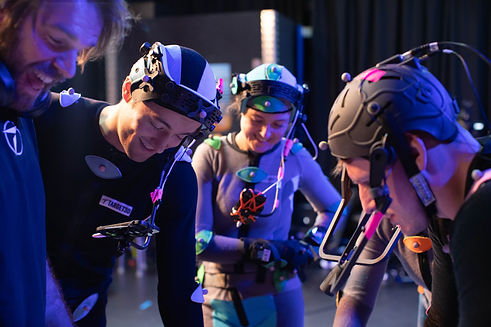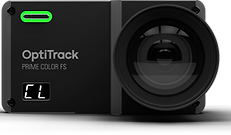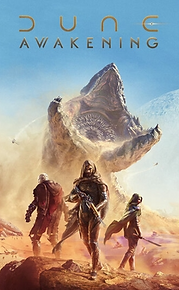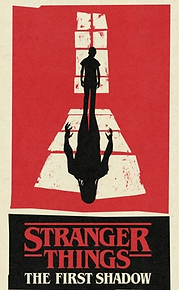
motion capture Services
StudioT3D blends real-time technology, performance artistry and deep tech expertise: all under one roof in London and Gateshead
We've been delivering high precision motion capture for nearly a decade
As part of Target3D, motion capture technology resellers, we’re not just end users of the tech - we’re experts who help develop the pipelines. This gives us direct access to firmware updates, beta tools and the knowledge to tweak for the highest precision possible.

Services
We live and breathe motion capture. Here's just a taste of what we can do...
Capture up to 8 performers in full performance capture
That's right. Eight performers - recording face, body and finger data - all in the same volume, in the same take.
Enjoy our massive 16m x 12m volume - stunt ready
Capture the way you want to in our huge volume - no scene is too much for us, and we'll be flexible to make your vision work.
Wet or Dry Hire plus on-site shoots available
Our engineers can run your shoot in our studios, or simply bring your crew in. We also offer on-site shoots at your location.
Realtime Previz in Unreal Engine
Directors and Performance Consultants can access a live feed to see actors in an Unreal Engine environment in real time.
Realtime Face Monitoring
If opting for full performance capture, we share a live feed of each actor's face camera to allow you to observe the capture quality and performance.
Types of Motion Capture
StudioT3D offers three world-class motion capture methods - optical, inertial, and markerless - so you can choose the tool best suited to your creative and technical needs.
Optical
Marker-based motion capture.
How it works: Multiple cameras track performers wearing reflective or LED markers to capture ultra-precise movement data in 3D space.
Why we use it: Ideal for fully detailed capture - body, face, and fingers - with sub-millimetre accuracy and low latency, even in multi‐actor setups.

Inertial
IMU-based motion capture.
How it works: Performers don suits embedded with accelerometers, gyroscopes, and magnetometers (IMUs) to capture movement data without cameras.
Why we use it: Entirely portable and flexible. Capture indoors, outdoors, or in tight spaces, with fast setup and minimal infrastructure

Markerless
Camera and AI
How it works: Advanced vision based systems use depth cameras and AI to infer a 3D skeletal rig from video footage - no markers, no suits.
Why we use it: Quick to deploy, unobtrusive for actors, and great for natural performances in diverse environments.

Recent projects
Powered by OptiTrack
We house a motion capture system from the world's largest motion capture supplier.


Hybrid Content Creation
We are the only facility of its kind in London to house a volumetric, virtual production and motion capture stage. Enquire about how you can utilise multiple content creation methods for your project.
Challenging briefs welcome
Experts in atypical and bespoke motion capture.
Animal Mocap
Puppet mocap
Children's Mocap

Need a refresher?
Motion capture (mocap) is the process of recording the movements of real people, animals or object paths and analysing that data or mapping the movements onto a CG character so the digital character moves just like the real actor.

The very early stages of this technique were called rotoscoping, this involved taking the performances of actors in a live action set and basically tracing over their movements with a pencil and paper. Animator Max Fleischer invented "rotoscoping" in 1914, a method of creating cartoons like Out of the Inkwell by tracing live-action footage, frame by tedious frame. The first use of rotoscoping in a feature film was in Disney's Snow White and the Seven Dwarfs from 1937.
Motion capture is heavily used in the video game industry and is also utilised in both live action films as well as full feature length animated movies. The film Polar Express was the first full length feature film to use motion capture entirely. Early on, mocap was a studio-only process where tight-suited actors were alone in barren sets surrounded by special cameras and lights. Avatar introduced "performance capture," which added multiple performers, facial expressions and lip movement. Games like L.A. Noire also drastically improved realism by combining facial and full-body capture. Lord of the Rings, meanwhile, brought mocap out of the studio and onto the set, allowing pioneering mocap actor Andy Serkis to interact with other actors as Gollum.
There are several different methods to get the motion capture data, the one you’re probably most familiar with is using the suits with the small lights or reflective balls that are placed on the different areas of the actor. This is called Optical motion capture, either passive or active depending on the markers you are using. Optical systems work by tracking position markers or features in 3D and assembling the data into an approximation of the actor's motion. Active systems use markers that light up or blink distinctively, while passive systems use inert objects like white balls or just painted dots (the latter is often used for face capture).
Other methods of motion capture include Inertial, Markerless & Magnetic.

Contact Us
Let's talk about your project.

Our Team
See who you'll be working with and put a face to the name.













